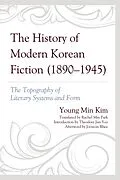This book explores the history of modern Korean literature from a sociocultural perspective. Rather than focusing solely on specific authors and their works, Young Min Kim argues that the development of modern media, shifting conceptualizations of the author, and a growing mass readership fundamentally shaped the types of narratives that appeared at the turn of the twentieth century. In particular, Kim follows the trajectory of the sin sosol (new fiction) as it meshed with the new print and media culture to give rise to innovative and hybrid genres and literary styles. In doing so, he compellingly illuminates the relationship between literary systems and forms and underscores the necessity of re-locating literary texts in their sociohistorical contexts.
Autorentext
Young Min Kim is former director of the Institute for the Study of Korean Modernity and professor in the Department of Korean Language and Literature at Yonsei University.
Inhalt
Part I: The Birth of the Modern Literary System and the Transformation of the Cultural Landscape
Chapter 1: Modern Publication Mediums and the Appearance of the Chappo (Miscellaneous News) Section and Sosl (Fiction)
Chapter 2: The Birth of the Modern Writer and Copyrights
Chapter 3: The Formation of Modern Readers and the Establishment of Systems for Reader-Submitted Works
Part II: The Development of Modern Narratives and Changes in Fiction's Form
Chapter 4: Changing Conceptualizations of New Fiction (Sin sosl) and their Literary Significance
Chapter 5. The Appearance of Short Stories and the Diversification of Narrative Forms
Chapter 6: The Lengthening of Narratives and the Development of Modern Long-Form Fiction (Changp'yn sosl)
